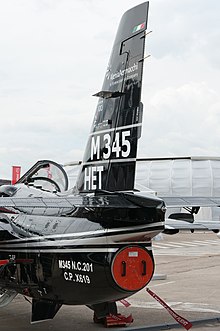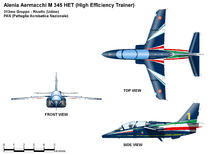Aermacchi M-345
| M-345 | |
|---|---|

| |
| A production Aermacchi M-345 trainer aircraft[1] | |
| Role | Basic/advancedtrainer[2]andlight attack aircraft |
| National origin | Italy |
| Manufacturer | Leonardo S.p.A.(exAlenia Aermacchi) |
| First flight | 29 December 2016 (M-345 prototype) 21 December 2018 (M-345production aircraft[2]) |
| Status | In active service |
| Primary user | Italian Air Force |
| Number built | 4 |
| Developed from | SIAI-Marchetti S.211 |
TheAermacchi M-345[3]is aturbofan-powered militarytrainer aircraftdesigned and produced by the Italian defense conglomerateLeonardo S.p.A.
It is a development of theSIAI-Marchetti S.211.On 29 December 2016, the M-345 performed itsmaiden flight;one month later, the first order for the type was placed by theItalian Air Force.The first production-standard M-345 was flown fromVenegono Superiorein December 2018; and entered service in December 2020 replacingMB-339.
Development
[edit]Origins
[edit]
During 1997, Italian aircraft manufacturerAermacchiacquiredSIAI-Marchetti;this purchase included the rights to the latter'sS.211,a jet-powered trainer aircraft.[4]In 2004, the company announced its intention to develop an improved version of the S.211, then referred to as the M-311. At the time, Aermacchi was also developing theM-346 Master,which serves as a lead-in fighter trainer; considerably smaller than the M-346, the M-311 was intended to perform both the basic and advanced training syllabus, as well as tactical training functions, as an alternative to single-enginedturboprop-powered competitors.[4][5]
Being based on the S.211, the M-311 featured an advanced new cockpit, various structural enhancements (including the increased use ofcomposite materials) and a new powerplant in the form of thePratt & Whitney Canada JT15D-5Cturbofanengine.[6]The changes allowed for an extendedfatiguelife of 15,000 flight hours, increased intervals between overhauls and a reduced turnaround time between sorties.[5]According to the manufacturer, the M-311's life-cycle costs could be brought into line with those of its turboprop rivals, the direct operating cost is only 5% higher despite a fuel-burn penalty of roughly 30%. Aermacchi's competitive analysis director Sergio Coniglio stated low maintenance costs shall be a decisive factor in the M-311's competitiveness against increasingly sophisticated competition.[5]
On 1 June 2005, the firstprototypeaircraft conducted itsmaiden flight.[7]A second aircraft, which had previously been used as atechnology demonstratorduring the 1990s, incorporating most features of the envisioned production model, was also produced. By September of that year, the prototype had reportedly flown 30 flights, and was set to receive software upgrades to enhance its cockpit displays.[5]During July 2006, one of the prototypes was displayed at theRoyal International Air Tattoo.[8]
During mid-2006, the company announced that it hadforecastdemand for a production run of up to 350 M-311s by 2030.[9]On 28 May 2008, Boeing and Alenia signed a joint agreement to cooperate on marketing, sales, training and product support for both the M-346 and M-311.[10][11]
Relaunch
[edit]
During 2012, the M-311 was revised, updated and re-designated by Alenia Aermacchi as theM-345 HET(High Efficiency Trainer).[2]During October 2014, it was announced that theWilliams International FJ44-4Mturbofan engine had been selected to power the in-development trainer, having overcome rivaling bids from bothHoneywellandPratt & Whitney.[12]The company stated that Williams' engine has been selected due to its performance in the business aviation sector and with theSwedish Air Force's re-engined fleet ofSaab 105trainers. Shortly thereafter, Alenia Aermacchi began installing the 3,400 lb-thrust FJ44-4M onto its flight-test aircraft, replacing the existing P&W Canada JT15D units.[12]
In March 2015, Alenia andENAERof Chile signed a memorandum of understanding, to explore the possibility of jointly manufacture and sell the M-345 HET inSouth America.[13]On 1 June 2015, Alenia Aermacchi presented the M-345 to the DGA for the nascent French replacement program for itsDassault/Dornier Alpha Jets.[14]On 20 September 2018, Alenia Aermacchi signed a memorandum of understanding with South African defense companyParamount Groupto evaluate and develop a combat-orientated model of the M-345 to suit the requirements of prospectiveAfricancustomers.[15]
The M-345 first flew on 29 December 2016.[16]The first production-standard M-345 was flown fromVenegono Superiorein December 2018; at this point, service entry with the Italian Air Force was anticipated to occur during 2020.[17]In December 2020, into entered service.[18]
Service
[edit]In December 2020 the first of 2 M-345 were accepted into service with the Italian Air Force, the first of the total order.[18]At least 18 are on order, although the Air Force anticipates acquiring at least 45.[18]The M-345 are replacing 137 MB-339 which entered service in the early 1980s.[18]
Design
[edit]
The Aermacchi M-345 is a compact twin-seat shoulder-wingmonoplanetrainer aircraft. It is based on the earlier S.211 and features structural and equipment improvements,[4]and new systems. The airframe has been strengthened, while aglass cockpitand modernavionicshave been installed. It is furnished with a retractabletricycle landing gear,powered by a singleWilliams FJ44-4M-34turbofanengine. As a basic trainer, the M-345 is designed to complement theAermacchi M-346advanced jet trainer.[4]It has been designed with a secondaryclose air supportcapability, being furnished with four[19]underwinghard points.
Both the pilot and instructor, which are seated in atandemconfiguration, are provided withHands-On-Throttle-And-Stick(HOTAS) controls.[4]Both crew are seated uponMartin-Baker-builtMk.IT16D'zero-zero' ejection seats.The cockpit's internal dimensions have been increased to be broadly identical to those of theBAE Systems Hawk.The displays and all light sources have been selected for compatibility withnight-vision goggles(NVG).[4]The environmental control system cools the cockpit for ground operations in temperatures up to ISA +35 °C (95 °F); the presence of an On-Board Oxygen-Generation System (OBOGS) removes the need foroxygenbottles.[4]
The M-345's glass cockpit features various avionics and last generation Human-Machine Interface.[19]Displays include three identical 5 x 7in (125 x 180mm) colour Multi-Functionliquid-crystal Displays(MFD),[19]a forward-mounted wide-angleHead-Up Display(HUD), while the rear position is provided with a full-sized HUD repeater via a fourth dedicated multifunction display.[4]The integrated avionics suite includes dual mission computers, embeddedGlobal Positioning System/inertial navigation systemandRadar Altimeter (EGIR),[19]two V/UHF radios, integrated centralAudio Warning,IFF Transponder,Traffic Alert System (TAS),Traffic Collision Avoidance System (TCAS)[19]and, optionally, adigital moving map,stores management system, and an embedded simulation capability (Embedded Tactical Training System - ETTS[19]- identical to that offered on the M-346). The latter is able to simulate a tactical scenario with threats and targets, presence of realistic Computer Generated Forces (CGF), on-board sensors (multimode Fore Control Radar, targeting pod and active/passive electronic countermeasures), weapons.[19]
Conventionalaileronsarehydraulically boosted,with provisions for manual reversion, while both theelevatorandrudderare mechanically actuated via pushrods, with three-axis electrical trimming.[4]Secondary flight controls are simpletrailing edgeflaps,which are electrically actuated, and a belly-mountedair brake,which is electrically controlled and hydraulically actuated. The 207bar (3,000 lb/in2) hydraulic system is used to operate thelanding gear,wheel brakes, air brake and aileron boost; the electrical system isDCwith internal-batteryengine start. The M-345 is suited for a two level maintenance concept, organizational and intermediate, for aircraft, equipment and system, whilst an on-boardHealth and Usage Monitoring System (HUMS)enables data collection and monitoring, contributing to the long life of the airframe and simplifying maintenance activities.[4][19]
Operational history
[edit]During January 2017, Italy placed an initial order for five M-345s for theItalian Air Force(IAF). The service has a requirement for up to 45 aircraft to replaceAermacchi MB-339sused in both the basic training role and by theFrecce Tricoloriaerobatic team.[20][21]In June 2019, Italy placed a follow-on order for an additional 13 M-345s, bringing the total up to 18.[22]
In May 2020, the M-345 achieved its initial military certification.[23]During January 2021, the IAF inducted its first pair of M-345 trainers; the type will replace the MB-339A as the service's second and third phases of its pilot training programme.[24]In December 2020, the M-345 entered service, replacingAermacchi MB-339and supplementingMB-346 Master.[18]
In 2022, 61° Stormo which was established over 75 years prior operating fromLecce-Galatina Air Base,operates M-345, MB-339A/CD and M-346s supports flight training for international flight school.[25]
Variants
[edit]

- M-311
- Modernized and uprated version of theSIAI-Marchetti S.211,powered by aPratt & Whitney Canada JT15D-5Cturbofanengine. Two prototypes built.[26]
- M-345
- Redesignation of the M-311 from 2012, powered by aWilliams International FJ44-4Mturbofan engine.[12]
- T-345A
- Italian military designation for the M-345.[23]
Operators
[edit]Specifications (M-345)
[edit]Data fromM-345 - Leonardo Company[27]
General characteristics
- Crew:2
- Length:9.85 m (32 ft 4 in)
- Wingspan:8.47 m (27 ft 9 in)
- Height:3.74 m (12 ft 3 in)
- Wing area:12.6 m2(136 sq ft)
- Empty weight:3,300 kg (7,275 lb)
- Max takeoff weight:4,500 kg (9,921 lb)
- Fuel capacity:700 kg (1,500 lb)
- Powerplant:1 ×Williams FJ44-4M-34turbofanengine, 15.40 kN (3,460 lbf) thrust with 1,540 kg (3,400 lb) Max Thrust
Performance
- Maximum speed:740 km/h (460 mph, 400 kn)
- Stall speed:170 km/h (110 mph, 92 kn)
- Never exceed speed:795 km/h (494 mph, 429 kn)
- Range:1,410 km (880 mi, 760 nmi)
- Service ceiling:12,190 m (39,990 ft)
- g limits:+7.0/−3.5
- Rate of climb:23.97 m/s (4,719 ft/min)
- Thrust/weight:0.45
Armament
- More than 1,000 kg (2,200 lb) of weapons on four hardpoints, including gunpods, bombs, and rockets, with the capability to employ IR guided air-to-air missiles.
See also
[edit]Related development
Aircraft of comparable role, configuration, and era
References
[edit]- ^"Flying at 5,000 ft with the trainers of the Aircraft flickr gallery".September 2020.
- ^abc"Leonardo: first M-345 production aircraft performs its maiden flight"(PDF).October 2018.
- ^"M-345 - Leonardo Company".Retrieved3 May2019.
- ^abcdefghijCollins, Peter."FLIGHT TEST: Alenia Aermacchi M-311 - Bridging the gap."Flight International,7 May 2007.
- ^abcdDoyle, Andrew."M-311 set to face pilot scrutiny."Flight International,13 September 2005.
- ^"Aermacchi chapter."Flight International,21 July 2004.
- ^"Training aircraft",Projects(gallery), Airforce technology.
- ^Hoyle, Craig."RIAT: Alenia Aermacchi M-311 jet trainer in the black at Fairford."Flight International,14 July 2006.
- ^Hoyle, Craig."Fresh sales prompt MB-339 advanced jet trainer revival."Flight International,1 August 2006.
- ^Trimble, Stephen (29 May 2018),Alenia Aermacchi, Boeing join forces on jet trainer market,Flight International
- ^Boeing and Finmeccanica to Pursue International Trainer Aircraft Market(press release), Boeing, 26 May 2008, archived fromthe originalon 29 June 2008
- ^abcPerry, Dominic."Alenia picks FJ44 for M-345 trainer, mulls SF-260 replacement."Flight International,8 October 2014.
- ^"Enaer signs a Memorandum of Understanding with largest Italian Aeronautics company Finmeccanica-Alenia Aermacchi."Leonardo S.p.A.,25 March 2015.
- ^Perry, Dominic (16 June 2015)."Paris: France plans Alpha Jet replacement".Flightglobal.Retrieved26 June2017.
- ^Hoyle, Craig."Leonardo eyes African market for armed M-345."Flight International,27 September 2018.
- ^Stevenson, Beth (3 January 2017)."Maiden Flight for M-345 Trainer".Flightglobal.Retrieved26 June2017.
- ^Perry, Dominic (21 December 2018)."Leonardo flies first production-standard M-345".Flight Global.London. Archived fromthe originalon 22 December 2018.Retrieved22 December2018.
- ^abcde"Italy inducts first M-345 trainers".Janes.com.Retrieved2023-10-29.
- ^abcdefgh"M-345 brochure"(PDF).
- ^Niccoli, RiccardoAir InternationalJuly 2017, p. 11.
- ^Hoyle, Craig."Italian deal opens M-345 order book."Flight International,16 January 2017.
- ^Perry, Dominic (13 June 2019)."Italy orders 13 additional M-345 trainers".FlightGlobal.London.Archivedfrom the original on 13 June 2019.Retrieved13 June2019.
- ^abHoyle, Craig (11 May 2020)."Leonardo gains initial certification for M-345".FlightGlobal.Retrieved14 May2020.
- ^Jennings, Gareth (4 January 2021)."Italy inducts first M-345 trainers".janes.com.
- ^Cenciotti, David (2022-09-07)."Italian Air Force Flight School Stages 'Elephant Walk' With 27 Jet Trainers".The Aviationist.Retrieved2023-10-29.
- ^"S.211"(production list).NL:SIAI-Marchetti. Archived fromthe originalon 28 October 2006.
- ^"M-345 - Leonardo Company".www.leonardocompany.com.Retrieved3 May2019.
Sources
[edit]- Niccoli, Ricardo (December 2006). "Italy's 21st Century Trainer - The Alenia Aermacchi M-311".Air International.Vol. 71, no. 6. pp. 32–37.ISSN0306-5634.
- Niccoli, Ricardo (July 2017). "High Efficiency Trainer".Air International.Vol. 93, no. 1. pp. 8–11.ISSN0306-5634.
External links
[edit]- M-345: Jet performance at turbo-prop costs,Leonardo
- "M-311 – Basic Jet Trainer/Light Combat Aircraft",Projects,Airforce technology
